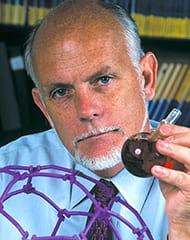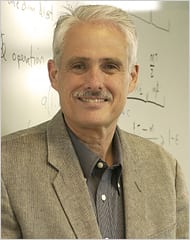Two professors named to top academic rank
By Jade Boyd
Rice News staff
April 18, 2002
Two of the most distinguished members of Rice University’s faculty, Richard Smalley and Ken Kennedy, have been named to the position of university professor, the institution’s highest academic title.
Smalley and Kennedy join Neal Lane as the only members of Rice’s faculty ever to hold the title of university professor, an appointment that entitles the holder to teach in any department at the university. Lane received his appointment as university professor in 2000 when he returned to Rice after serving first as the director of the National Science Foundation (NSF) and later as President Clinton’s chief science and technology adviser.
“The title ‘university professor’ is one of the highest honors available in the American universities having such a rank,” said Malcolm Gillis, president of Rice University. “At Rice, the board of trustees awards the title only after receiving strong endorsements from the president, the provost and the deans. The addition this year of Rick Smalley and Ken Kennedy constitutes further evidence of their long-standing and fundamental contributions to their disciplines, and to Rice University.”

Rick Smalley
Smalley helped usher in the age of nanotechnology with the discovery in 1985 of fullerenes, a molecular form of carbon that is distinct from graphite and diamond, the only two forms previously known. The discovery earned Smalley a share of the 1996 Nobel Prize in Chemistry. Smalley, the Gene and Norman Hackerman Professor of Chemistry and professor of physics, shares the Nobel Prize with fullerene co-discovers Robert Curl, Rice’s Harry C. and Olga K. Wiess Professor of Natural Sciences, and Harold Kroto of the University of Sussex in Brighton, England.
Kennedy, the Ann and John Doerr Professor of Computational Engineering and professor in electrical and computer engineering, is one of the nation’s foremost experts on high-performance computing. Kennedy was appointed in 1998 to co-chair the Clinton White House’s Information Technology Advisory Committee, a group charged with reviewing the effectiveness of all of the nation’s federally funded research and development in information technology.
“In naming Rick Smalley and Ken Kennedy as university professors, the board of trustees has recognized two individuals who have made broad and sustained contributions to Rice throughout their entire careers,” said Rice University Provost Eugene Levy. “Their contributions span decades, cross boundaries within the university and contribute to the university’s distinction across the nation and around the world.”
Smalley received a bachelor’s degree in 1965 from the University of Michigan and a doctorate from Princeton in 1973. He joined Rice’s faculty in 1976, and helped found the Rice Quantum Institute three years later. He was named the Gene and Norman Hackerman Chair in Chemistry in 1982, appointed a professor of physics in 1990 and founded the Center for Nanoscale Science and Technology in 1995. Smalley is director of both the Carbon Nanotechnology Laboratory and Rice’s new Center for Biological and Environmental Nanotechnology, one of six nanotechnology research centers funded by the NSF.
Smalley is a member of the National Academy of Science, the American Academy of Arts and Sciences, the American Chemical Society, the American Physical Society and the American Association for the Advancement of Science.
“This is a great honor from the great university that has been my home and passion for the past 25-plus years,” Smalley said.

Ken Kennedy
Kennedy, who received his bachelor’s degree from Rice in 1967, joined the university’s faculty in 1971 after earning his master’s and doctorate at New York University. Kennedy founded Rice’s computer science department in 1984, was named the first director of Rice’s Computer and Information Technology Institute in 1987, and in 1988 led a group of computer scientists from seven leading research institutions in a proposal to establish the NSF-funded Center for Research on Parallel Computation (CRPC). In 1998, the CRPC became the Center for High Performance Software Research, or HiPerSoft, a group Kennedy still directs. He currently leads two multi-institutional research efforts: the Los Alamos Computer Science Institute, a consortium of five universities and the Los Alamos National Laboratory, and the Grid Application Development Software Project, an NSF-sponsored effort involving eight universities. His research focuses on developing high-level programming tools for parallel and distributed computer systems.
Kennedy is a member of the National Academy of Engineering, the Institute of Electrical and Electronics Engineers, the Association for Computing Machinery and the American Association for the Advancement of Science.
“As a Rice alumnus and faculty member, I’m deeply honored to be appointed university professor,” said Kennedy. “I am excited to have this opportunity to build upon the cross-disciplinary and multi-institutional research and education efforts that I have pursued throughout my career.”


Leave a Reply